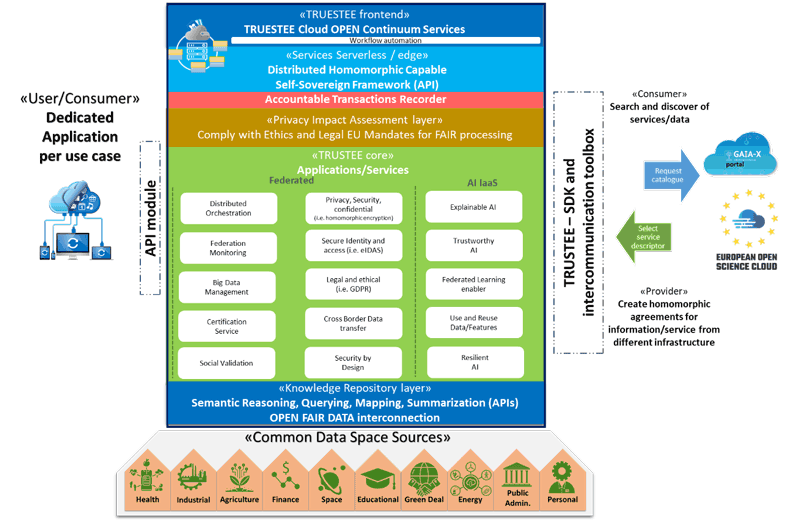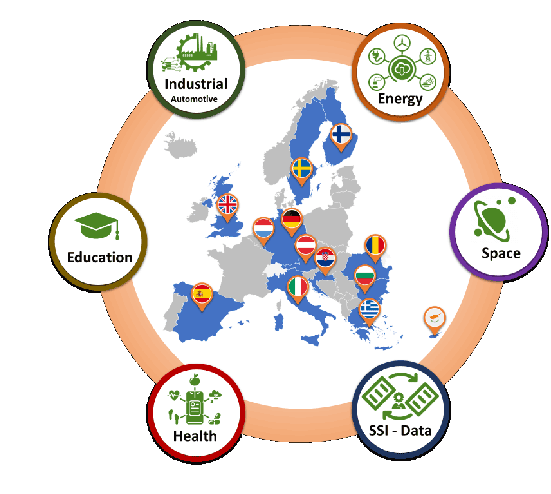by Emmanouil Spanakis (ICS-FORTH), Evangelos Markakis (HMU), Dimitra Papatsaroucha (HMU), Ilias Polits (INQBIT) and Vangelis Sakkalis (ICS-FORTH)
Utilising self-sovereign technologies and with state-of-the-art homomorphic encryption, TRUSTEE offers a socially and environmentally aware framework for cross-discipline federation of data.
Nowadays, there is a general trend in the field of informatics towards the connection of multidisciplinary scientific fields such as health, space, automotive, education, cross-border and environment. The number of opportunities derived from this trend is impressive and includes the possibility to prevent future accidents/problems and security attacks, and also to tackle scientific problems where the social conditions and innovation form a complex matrix. Thus, it is evident that there is a need to measure how well existing technologies can be used to improve the availability and quality of multidisciplinary big-data sources, from various sectors, in a trustworthy, fair, responsible, and environmentally friendly manner, across the data life cycle to enable data sharing and manipulation, in compliance with prevailing and emerging legislation.
TRUSTEE EU project [L1] aims to combine technological and social innovations for secure and sustainable data operations in line with the principles of responsible/trustworthy AI by using a co-development approach as backbone methodology. TRUSTEE proposes a secure-by-design federated platform in line with EU data strategy (COM (2020) 66), and the main EU reference architectures (GAIA-X, EOSC, EGI) in the sector, able to ensure interoperability, enabling cross-border scenarios, and to scale varieties of AI-based applications, by using open APIs focusing on making the EU the world’s most secure and trustful data hub. More than that, TRUSTEE acknowledges that today consumers must be very careful about sharing/accessing data, and national and international regulators/legislators step up privacy requirements. The industry needs to identify how investing in data protection and privacy can create a business advantage for the proper handling of data, consent, notice and regulatory obligations; how data is securely shared with third parties; how data is legally collected or stored; how data can be collected for processing; and regulatory restrictions such as GDPR, HIPAA, GLBA, or CCPA. Several effective actions have emerged seeking to address enhanced consumer-privacy and data-protection requirements. These span the life cycle of enterprise data, and expand the processes of operations, infrastructure and customer-facing practices, and are enabled by data mapping.
To achieve all these, we exploit an innovative homomorphic approach that guarantees user-friendly, safe, trustworthy, compliant, fair, transparent, accountable and sustainable collection, storage, processing, querying and delivery of data. The project factors three key areas: serverless computing, edge computing and secure clouds, to deliver an open-source, scalable, efficient and trusted solution, able to seamlessly operate on core and edge cloud infrastructures for time-critical, self-hosted applications, in a European, privacy-preserving, green and responsible data-centric model.
We utilise enhancements in self-sovereign technologies with the use of blockchain for the decentralised identifiers and homomorphic encryption for the cross-discipline federation of data. Data consumers will be able to operate over a framework that will not know anything about their identity, nor their equipment, which will allow them to perform complex search queries across the federated data repositories and communicate through robust authentication and authorisation mechanisms. Hence, the system can reveal only the necessary data for any given transaction or interaction. The goal is to create a framework aiming towards privacy preservation, green and responsible management, giving individuals or organisations full ownership of their digital and analogue identities, and control over how their personal data is shared and used, enabling search in the encrypted domain, while guaranteeing data privacy and data confidentiality as the data remain encrypted.
TRUSTEE promotes vital cross-functional collaboration and automation to build fast, trustworthy data pipelines. The overall goal is to create a data-driven platform that envisages cutting-edge solutions, and promote trustworthy green and responsible data management and processing, through value-based digital technologies and solutions for compliance, privacy homomorphic encryption and preservation. In Figure 1 we present our architectural designs aiming to satisfy the requirements of citizens, industry and research for federated data access through a private framework of public and private organisations. Table 1. presents the architecture schematics of TRUSTEE.
| Main subsystems / layers of TRUSTEE architectural design (Figure 1) | |
| Front-end layer | Point of access for the end-user (consumers) or service APIs FOR devices, users, and federated service access layer |
| Accountable transaction layer | Responsible to record every single transaction of the users with the data while permitting private transactions |
| Homomorphic and self-sovereign framework |
Trust and Security ensure that identity and privacy are managed across federated instances of the TRUSTEE framework. |
| Cloud continuum service layer | Cloud-based service continuum knowledge base for TRUSTEE |
| TRUSTEE core layer | Advanced multi-dimensional/sector approach to promote situational/context awareness of the EU data common spaces procedures for processing |
| Knowledge repository | Fuse data coming from those heterogeneous sources and will be integrated based on data homogenisation and semantic alignment toolkits |
| Common data space sources | The data collection sources are shown in the bottom layer where various (structured and unstructured data sources) |
Table 1: Summarised architecture schematics of TRUSTEE.

Figure 1: High level architecture of TRUSTEE Platform.
TRUSTEE emphasises social innovation and privacy impact assessment through the proposed technologies by optimising processing at the edge, resilience, transfer and storage, avoiding unnecessary manipulations in line with responsible/trustworthy AI principles. Our architecture supports FAIR communication with open data silos and platforms to exchange existing and future data originating from various EU data spaces are thus empowers stakeholders with user-friendly, safe, trustworthy, transparent, accountable and sustainable ICT services for collecting, storing, processing, querying and delivering data. TRUSTEE’s fully encrypted solution will be validated through six different use cases supporting GAIA-X, EOSC, EGI, etc. demonstrating a multi-disciplinary, Pan-European federated FAIR and private data ecosystem. Figure 2 presents the six different areas for validation.

Figure 2: TRUSTE Use cases / Pilots.
Link:
[L1] https://horizon-trustee.eu/
Please contact:
Emmanouil Spanakis, ICS-FORTH, Greece
+30 2810 391446











